
SanDisk’s X400 is the successor to the X300/X300s series and is aimed at the corporate/mainstream market segments. It can be seen as an improved combination of both previous drives as it has the 256-bit AES encryption of the S version of the X300 built in as standard. The X400 family features SanDisk’s 6th generation 15nm Triple Level Cell TLC NAND and just like the previous X300 uses SanDisk’s nCache technology where some of the NAND runs in SLC mode to bolster performance.
The Sandisk X400 series is available in two formats; 2.5in, built on a 7mm form factor or as a 2280 M.2 drive and both formats come in 128GB, 256GB, 512GB and 1TB capacities. Incidentally SanDisk claim that the 1TB M.2 X400 has a couple of world firsts under its belt. It’s the first single sided 1TB M.2 drive and as a result is also, at 1.5mm, the thinnest M.2 drive at that capacity.
The three smaller drives in the range (both formats) have quoted Sequential read performance of up to 540MB/s, the 1TB drive is very slightly faster at 545MB/s. Sequential write performance varies, as the 1TB, 512GB and 256GB capacities are all quoted at up to 520MB/s while the 128GB drives write performance drops to a quoted maximum of 340MB/s.
When it comes to IOPS performance the 1TB drive once again has better quoted read figures than the rest of the range of up to 95,000 IOPS, some 1,500 IOPs more than the other three drives. Write IOPS performance for the 1TB, 512GB and 256GB is up to 75,000 IOPS with the 128GB drive making do with up to 60,000.
Endurance figures for the range start at 72TBW for the 128GB drive up to 320TBW for the 1TB drive which works out around 39GB writes a day for the 128GB and 175GB for the 1TB drive over the period of the 5 year warranty SanDisk provide for the drives.
Physical Specifications:
- Usable Capacities 128GB, 256GB, 512GB and 1TB.
- NAND Components SanDisk 15nm Triple-Cell (TLC).
- Interface Serial ATA (SATA) 6Gb/s (SATAIII).
- Form Factor 2.5inch, 7mm height.
- NAND Controller Marvell.
- Dimensions (L x W x H) mm 100.5 mm x 69.85 mm x 7.0 mm
- Weight 37.4g
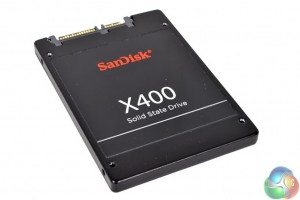
The Sandisk X400 uses a 2.5in, 7mm format chassis and weighs in at 37.4g (59.7g for the 1TB version).
It measures 100.5 mm x 69.85 mm x 7 mm.
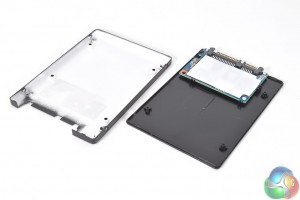

The PCB for the 256GB model is very small not even reaching half way along the enclosure. A thermal pad very nearly covers the whole area of the PCB keeping two NAND packages, the controller and the cache IC cool. The PCB is held in place by a couple of screws – undoing these reveals another two NAND packages on the reverse side of the board.
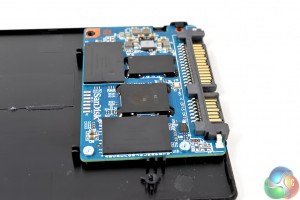
The four NAND packages are SanDisk’s own 15nm TLC NAND coded 05478064G. The cache chip is a Micron 256MB DDR3L-1600 package.
At its heart of the X400 is a Marvell 88SS1074-BSW2 four channel controller. Marvell’s fifth generation SSD controller is built on a 28nm process and supports up to 15nm TLC/MLC/SLC NAND as well as 3D NAND. It also supports DEVSLP, ONFI 3/Toggle 2, 256-bit AES encryption and TCG Opal 2.0 support.
SanDisk have recently updated their SanDisk Dashboard suite of utilities, a pretty comprehensive bunch of tools that allow you to monitor the drive in all sorts of ways. You can check the status of the drive; how the capacity is being used, how much life the drive has remaining and even the temperature of the drive.
The Performance part of the Dashboard allows you to test the drive as well as enabling TRIM and scheduling when it runs. The Tools section is where you’ll find the firmware updater and both Secure Erase and drive Sanitize as well as an S.M.A.R.T diagnostic tool and system and drive detail sections.
For testing, the drives are all wiped and reset to factory settings by HDDerase V4. We try to use free or easily available programs and some real world testing so you can compare our findings against your own system.
This is a good way to measure potential upgrade benefits.
Main system:
Intel Core i7 4790K with 16GB of DDR3-2133 RAM, GTX980 and an ASRock Extreme 6 motherboard.
Other Drives
Plextor M6V 256GB
Micron M600 256GB
Apotop S3C 256GB
Angelbird 512GB wrk
Hynix SH920/910A
OCZ ARC 100 240GB
OCZ RevoDrive 350 480GB
OCZ RevoDrive 3 x2 480GB
Intel 520 Series 240GB
Intel 730 240GB
Samsung 840 EVO 1TB
OCZ Vector 150 256GB
OCZ Vector 240GB
OCZ Vertex 450 256GB
OCZ Vertex 4 512GB
OCZ Vertex 4 128GB (1.4 fw)
ADATA Premier Pro SP900 128GB
OCZ RevoDrive Hybrid 1TB HDD/SDD
SanDisk Extreme II 240GB
Corsair Performance Pro 256GB
OCZ Agility 4 256GB
SanDisk Ultra Plus 256GB
Samsung 830 Series 512GB
Patriot Wildfire 240GB
OCZ Vertex 3 240GB MAX IOPS
ADATA S510 120GB
Kingston HyperX 3K 120GB
OCZ Octane 512GB (fw 1.13)
Samsung Spinpoint F3 1TB
Software:
Atto Disk Benchmark.
CrystalMark 3.0.3.
AS SSD.
IOMeter.
All our results were achieved by running each test five times with every configuration this ensures that any glitches are removed from the results. Trim is confirmed as running by typing fsutil behavior query disabledeletenotify into the command line. A response of disabledeletenotify =0 confirms TRIM is active.
Crystalmark is a useful benchmark to measure theoretical performance levels of hard drives and SSD’s. We are using V3.0.4.



The overall performance of the drive is pretty good for a mainstream drive and while the Marvell controller handles both incompressible and compressed data equally well, it does show a preference for the former when it comes to writes.
The ATTO Disk Benchmark performance measurement tool is compatible with Microsoft Windows. Measure your storage systems performance with various transfer sizes and test lengths for reads and writes. Several options are available to customize your performance measurement including queue depth, overlapped I/O and even a comparison mode with the option to run continuously.
Use ATTO Disk Benchmark to test any manufacturers RAID controllers, storage controllers, host adapters, hard drives and SSD drives and notice that ATTO products will consistently provide the highest level of performance to your storage.
When it comes to ATTO’s sequential tests the 256GB X400 manages to surpass the official read figure of 540MB/s at 555MB/s. It doesn’t quite manage the same feat when it comes to writes at 508MB/s.
AS SSD is a great free tool designed just for benching Solid State Drives. It performs an array of sequential read and write tests, as well as random read and write tests with sequential access times over a portion of the drive. AS SSD includes a sub suite of benchmarks with various file pattern algorithms but this is difficult in trying to judge accurate performance figures.

The AS SSD benchmark uses incompressible data to test drives. On the whole the Marvell controller deals with it quite well, but is let down a little by the 4K read and 4K-64Thrd write performance.
IOMeter is another open source synthetic benchmarking tool which is able to simulate the various loads placed on hard drive and solid state drive technology.
There are many ways to measure the IOPS performance of a Solid State Drive, so our results will sometimes differ from manufacturer’s quoted ratings. We do test all drives in exactly the same way, so the results are directly comparable.
While the random 4K read performance is pretty good at 79382 IOPS in reality it’s no better than many of its competitors. However the 4K random write performance at 42854 IOPS is quite disappointing.
The new Sandisk X400 combines both of its predecessors into one drive as it combines the solid performance of the X300 with the data encryption of the X300s. The Marvell 88SS1074-BSW2 controller in the X400 is more power efficient meaning lower power consumption than the previous two drive ranges through all aspects of the drives use from DEVSLP to maximum writes.
The 256GB drive has reasonable endurance, a quoted 80TBW or 43GB/day for the length of the 5 year warranty.
The toughest job for any company launching a mainstream drive in the 2.5in 240/256GB capacity bracket is to get the pricing right as this market segment is already a blood bath with so many drives vying for attention.
You can find the SanDisk X400 256GB for £62.70 via Scan UK which means it falls in the middle of the price range of drives of this capacity however there is a lot of competition.
Discuss on our Facebook page, over HERE.
Pros
- 256-bit encryption built in.
- 7mm format for thin laptop use.
- Five year warranty.
Cons
- SSD market sectors the drive is aimed at are extremely competitive with an overabundance of drives to compete with.
KitGuru Says: The X400 shows an improvement over the older X300 series, perhaps not so much in performance but in features such as built in encryption and a more power efficient controller.
 KitGuru KitGuru.net – Tech News | Hardware News | Hardware Reviews | IOS | Mobile | Gaming | Graphics Cards
KitGuru KitGuru.net – Tech News | Hardware News | Hardware Reviews | IOS | Mobile | Gaming | Graphics Cards







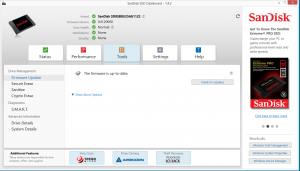




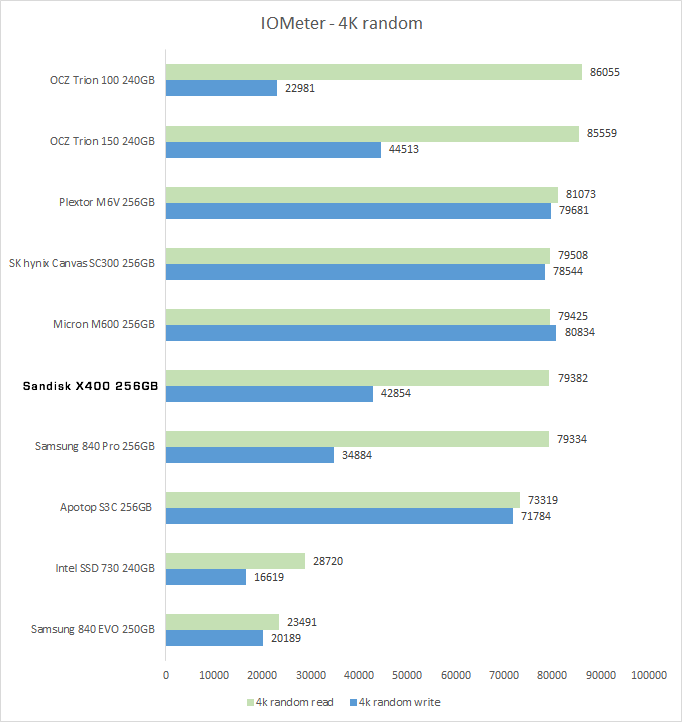





planar TLC NAND .. hells no!
cell voltage drift is a thing, didn’t these companies learned from Samsung’s fuck up with 840 EVO?